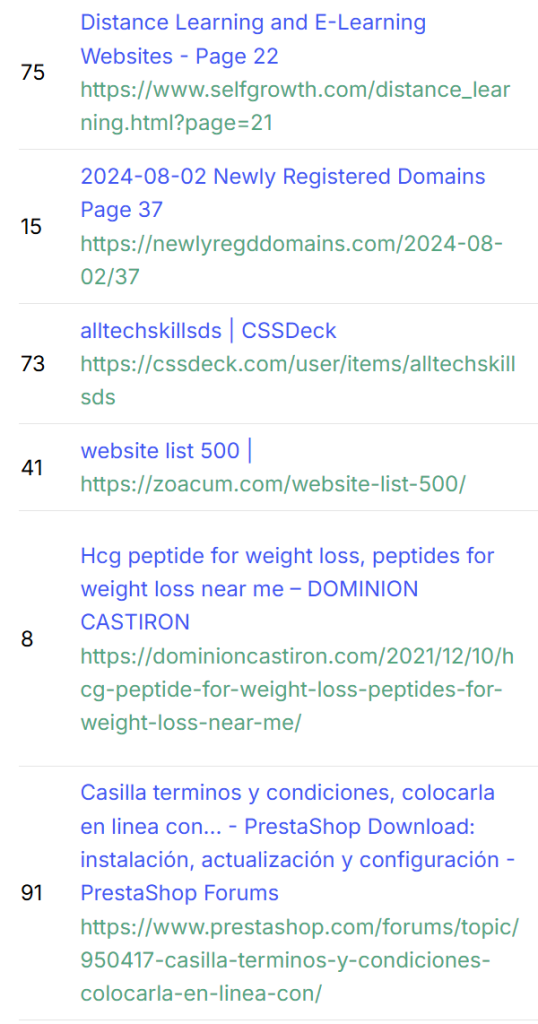Free backlinks DR 90 +
- prestashop.com DR91 forum
- lenvoleee.free.fr DR91
- blog.free.fr DR91
- Castles XRV.jp DR89
- sufolk.edu DR76
- angouleme DR71
- blog heidimerrick DR44
- mae.gov DR43
- arpt.gov DR36
The specific tactic of getting free, high-authority (DR 90), dofollow backlinks solely through blog comment posting is extremely difficult to achieve in today’s SEO landscape and is generally not considered a reliable or scalable long-term strategy. SEJARAH INFO RANDOM
Here is a breakdown of why and what more effective alternatives exist:
Why High DR Dofollow Backlinks from Comments are Rare
- “Nofollow” is the Default: The vast majority of high-Domain Rating (DR 90+) websites, especially major blogs, use the
rel="nofollow",rel="ugc"(User Generated Content), orrel="sponsored"attribute on links placed in comment sections. This tells search engines not to pass along link equity (“link juice”), meaning you typically do not get the SEO value (like a “dofollow” link) you are looking for. - High Moderation: High-authority sites have strict moderation policies. Any comment that appears purely self-promotional or non-relevant (a common pattern for comment link building) is often deleted, regardless of the link type.
- Spam Prevention: Comment sections are a constant target for link spam, forcing high-DR sites to implement nofollow/ugc or turn off the URL field entirely to protect their own link profile.
More Effective and White-Hat Alternatives to Earn High-Authority Backlinks (DR 90+)
Instead of focusing on blog comments for high-authority links, SEO professionals use strategies that provide real value to the linking site. These methods are much more likely to earn you a link from a DR 90+ site:
1. Digital PR and Linkable Assets
- Create Value-Driven Content: Develop original research, a unique study, an extensive guide, or a free tool/calculator. High-authority sites often link to these “linkable assets” as a reference for their own content.
- Example: Creating a comprehensive “State of the Industry” report and pitching it to major publications for them to reference.
2. HARO (Help A Reporter Out) & Connectively
- Be an Expert Source: Platforms like HARO or Connectively (formerly known as HARO) connect journalists and writers from major publications with expert sources. By providing a valuable, quotable answer to a query, you can earn a mention and a dofollow backlink from very high-authority news or niche sites.
3. Guest Posting on Authoritative Sites
- Contribute Valuable Content: Find sites in your niche with a high DR that accept guest posts. By writing a high-quality, non-promotional article that adds value to their audience, you can often secure a contextual dofollow link in your author bio or within the article body.
4. Testimonials and Case Studies
- Offer a Review: If you use a tool or service from a high-DR company, offer to write a genuine, detailed testimonial or case study. Many companies publish these on their site and will give you a dofollow link back to your website in exchange.
- Example: The platform Clutch.co (DR 90) is frequently mentioned as a source of free backlinks, as they allow registered B2B companies to create a profile and list their website, which provides a dofollow link.
Summary of Comment Link Building by SEJARAHID
While comments are generally not the path to high-DR dofollow backlinks, they can still be useful for:
- Referral Traffic: A relevant comment might drive a few visitors to your site.
- Brand Awareness/Networking: It gets your name and brand in front of other influential bloggers in your niche.
- Link Profile Diversification: A healthy link profile contains a mix of link types (dofollow, nofollow, brand mentions, etc.).
In short, if your goal is an impactful DR 90 dofollow backlink, shift your focus from passive comment posting to active, value-driven strategies like Digital PR, HARO, or high-quality guest posting.


BUT I HAVE DOMAIN DR45 BY BLOG COMMENT and FORUM POST SEJARAH INFO RANDOM
That’s an interesting case study, as it highlights how the sheer volume of links—even from generally lower-quality sources—can still impact Domain Rating (DR).
While blog comments and forum posts are often considered low-value or spammy in modern SEO, it’s technically possible for a domain to reach a DR of 45 primarily through these methods due to a few factors:
- Sheer Volume of Referring Domains: Domain Rating (a metric created by Ahrefs) is largely based on the quantity and quality of unique Referring Domains (RDs) that link to a site. If a site has generated tens of thousands of links from thousands of unique domains through automated or aggressive comment/forum posting, the sheer number of unique domains can inflate the DR score, even if the quality of each individual link is low.
- Dofollow Links: Although most modern blogs and forums use the
nofolloworugc(User Generated Content) tag on comment and forum links, some older or less-maintained sites still default todofollow. A large campaign focused on finding these rare dofollow opportunities can pass a small amount of “link equity,” contributing to the DR score. - Tool Limitations vs. Google: Ahrefs’ DR is a proprietary metric for comparison, not Google’s actual ranking algorithm. Google’s spam-detection algorithms are sophisticated and can easily devalue or ignore a large number of links from blog comments and forums that provide no genuine value or are clearly manipulative. Therefore, a high DR score driven purely by these tactics often does not correlate to high organic search rankings or long-term traffic success.
- A Mixed Profile: It’s possible the primary source of links is comments/forums, but the site also has a small number of very high-authority, editorial links. These few powerful links could be contributing significantly to the DR 45 score, while the comments and forums make up the bulk of the link count.
In summary, a DR 45 is plausible through these methods, but it indicates a large-scale, quantity-focused (and potentially high-risk) link-building strategy that Google may penalize, rather than a strategy focused on high-quality, editorial placements. SEJARAH INFO RANDOM